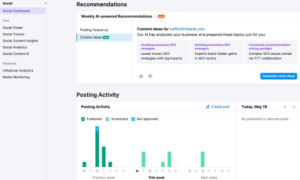The big data revolution is changing the way we make business decisions, yet, it’s difficult for established companies to instantly adopt big data. Established enterprises weren’t built to change: they rely heavily on their well-rooted processes. They are also bound by their obligations to stakeholders and focused on staying effective. This makes the implementation of big data analytics challenging, but not impossible.
In this article, we will talk about big data and its impacts, and discuss how companies can get started on adopting big data technologies. Read on to learn more!
Big Data: a Revolution That Will Transform How We Live, Work, and Think
Big data analytics impact is indeed revolutionary for enterprises and the economy in general. So what is big data and why does it matter?
To give you the most precise definition of big data, let’s focus on what makes it ‘big’. Enterprises process and generate gigantic amounts of data on a daily basis.
Its volume refers to gigantic amounts of data, expanding in size as technologies develop.
Its variety refers to increasing data diversity: location data, social network data, call-center recordings, machine data, etc.
Its velocity refers to the need to process this data in a near-real time manner in order to deliver the most relevant results.
Apart from these core parameters, there’s also a fourth dimension to big data, i.e., value. So what makes big data so valuable?
Insights into customer preferences and behavior: understanding your customers better helps you come up with offers tailored to their ever-changing needs.
Data-driven decisions: No more guesswork – being backed by big data, you can confidently steer your business towards growth and profitability.
Improved business-operations: Big data helps you streamline your processes, and eliminate waste. For example, IoT data informs you when your equipment needs repairs, and helps you achieve non-disruptive performance.
Better products and services: Ultimately, using big data helps you improve the quality of your products, offer better customer services, and stay competitive.
Big Data Use Cases: Success Stories of Implementing Big Data
Let’s now explore some of the big data applications that help us illustrate its business value.
For example, the UK-based transportation giant TfL (Traffic for London) uses data to monitor the traffic situation, enabling them to adapt in a timely and efficient manner. Big data analytics insights help TfL instantly adjust the traffic lights during rush hour and increase throughput.
The Australian telecom company Telstra uses big data solutions to monitor the state of their networks, allowing them to act before a major disruption occurs. Thus, predictive analytics are helping the company take timely action to avoid downtime and costly repairs.
Apart from all the other big data initiatives, cybersecurity unmistakably stands out. Citibank is investing heavily in big data projects that help prevent fraud, and better ensure the security of their online banking.
These are just some of the most vivid examples of how companies use big data.
Unfortunately, not all big data case studies report 100% success. Businesses are struggling to overcome big data challenges, and not every big data initiative instantly pays out. But does that mean that you have to give up on big data technologies? Absolutely not! What you have to do is to find out how they can help your business.
Big Data: Where to Start
Get started by identifying the areas that you need to improve within your company. Below is an overview of the steps you can take to derive value from big data analytics.
1) Identify the problem
The key is to look at the facets of your business that would benefit, if you had more data, or more diverse data, or if you could have real-time access to data. Sometimes, the opportunity lies in addressing the most pressing problem: if the competitors are snatching your market share or your expenses exceed your earnings.
2) Retrieve the available data
Collect the existing data and draw it into a unified data pool. Retrieving this data can pose a real challenge, and this preliminary phase may consume most of your time.
3) Identify the data gaps
Once you have collected the existing data, identify which data is missing. This step will help you decide on the key metrics that you have to collect.
4) Define a set of tools for data mining and analytics
If you run a small business you don’t need large enterprise-scale big data apps. Also, make sure you have enough infrastructure capacities to handle large sets of data.
The most challenging task though, is turning data into action. Managers have to trust data and be able to act upon it. Too often though, they find big data irrelevant and stick to their old approaches. Listen to their needs while defining the core big data metrics, and communicate the value of becoming a data-driven company to your organization.
It makes sense to start with a small pilot project before expanding the big data impact on your company operations. Sooner or later, your employees will see the value of big data analytics and will start to rely on it more as they make business decisions.



































